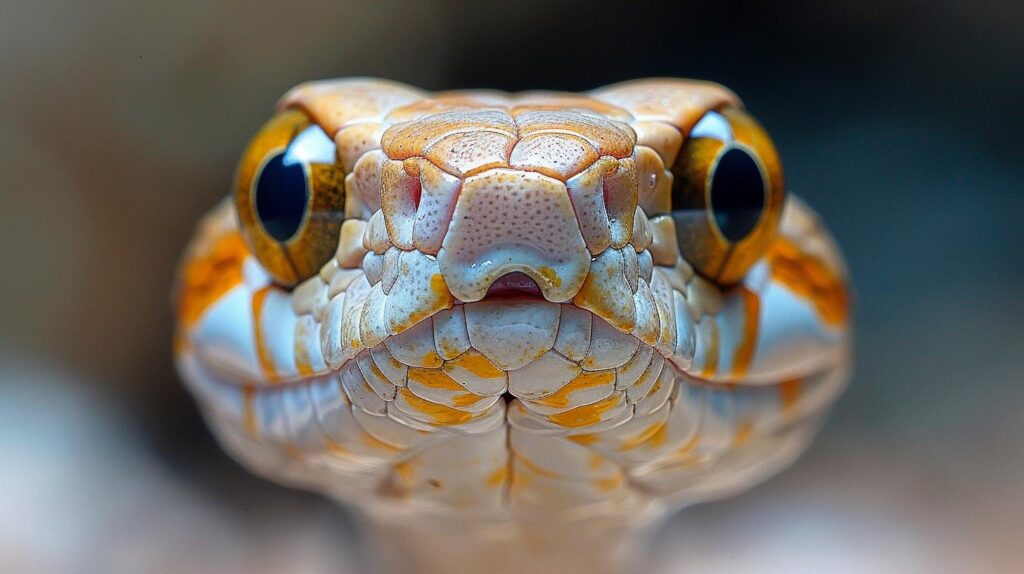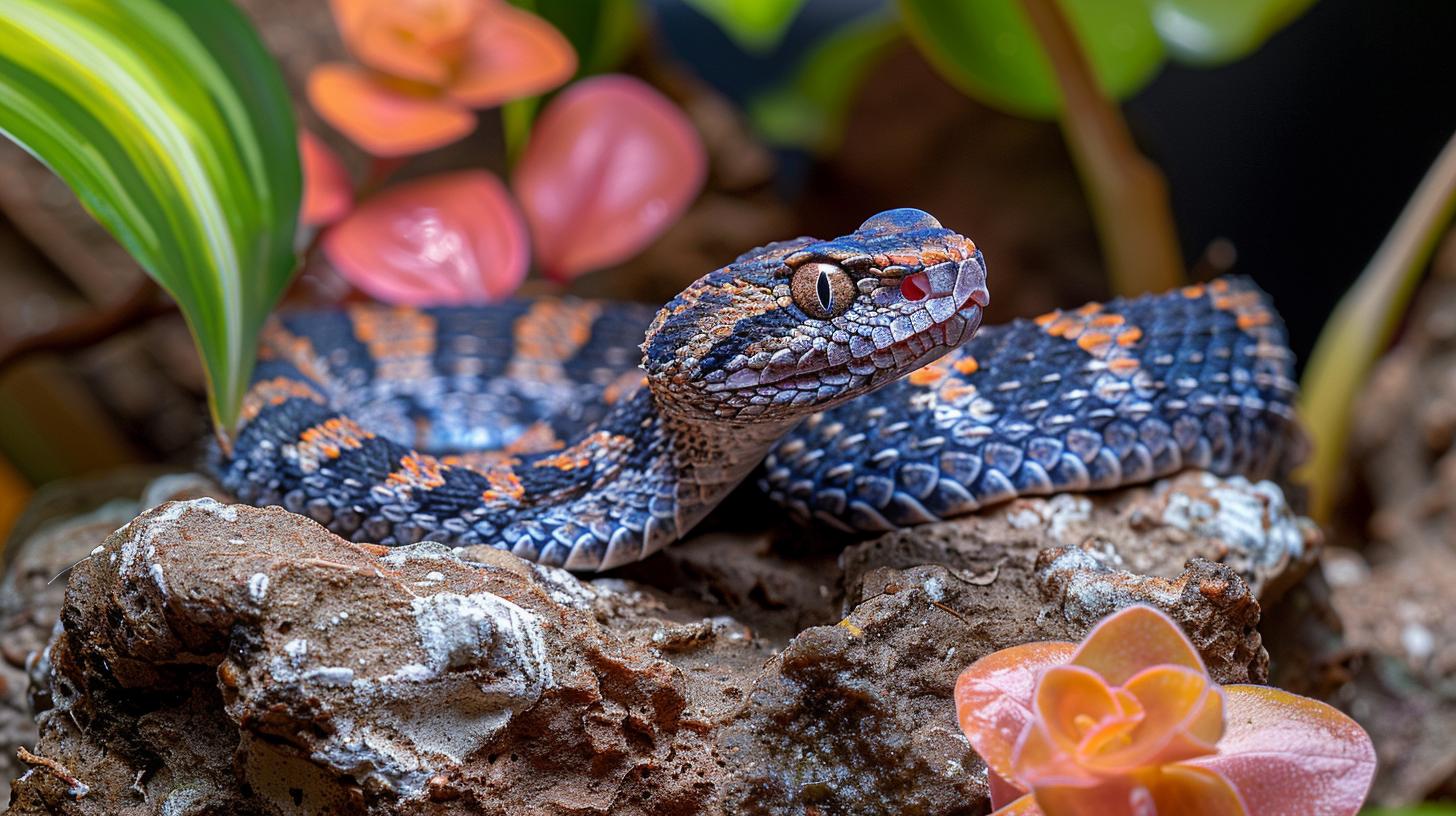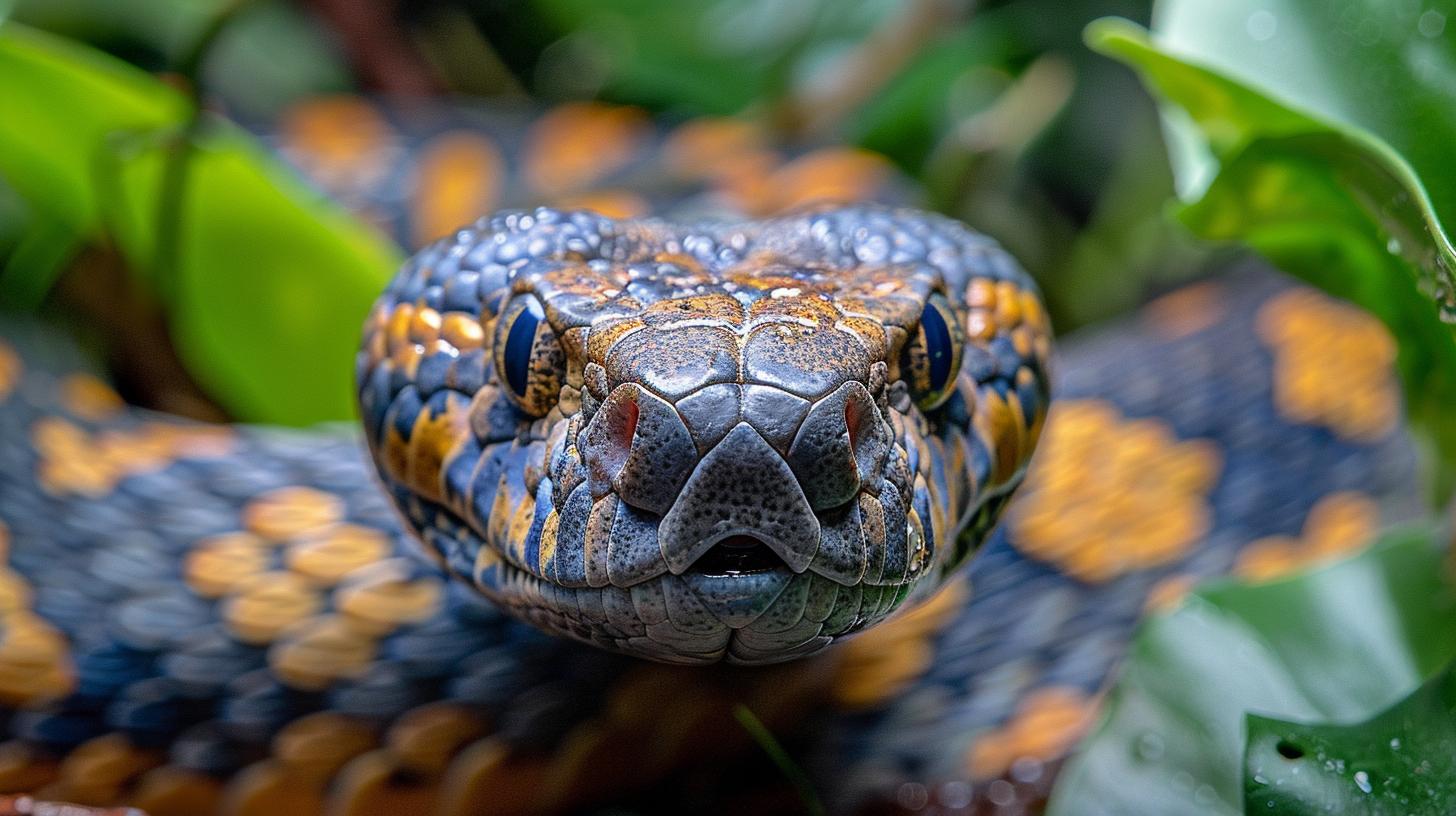Optimal Humidity Levels for Snake Enclosures Explained

Understanding the Importance of Proper Humidity in Snake Enclosures
Maintaining the right snake enclosure humidity is not just about following a care sheet; it's essential for ensuring your snake thrives in captivity. This balance of moisture in the air plays a pivotal role in their health, affecting everything from how they shed their skin to their overall hydration and well-being.
It's vital for snake owners to recognize the importance of creating an environment that mimics the natural habitat of their pet as closely as possible, stressing why understanding humidity isn't just beneficial but necessary.
The diversity among snake species means there's no one-size-fits-all answer when it comes to their care requirements, especially concerning humidity levels. Snakes hail from a variety of environments-ranging from the arid deserts where rain is rare, to lush tropical forests drenched in moisture.
For instance, a Ball Python, accustomed to the humid conditions of West and Central Africa, will have different needs compared to a Rosy Boa that thrives in the dry desert regions of Southwestern United States and Mexico. Highlighting these differences underscores not only the varying needs based on *species* but also throws light on why tailoring your enclosure's humidity is key.
For those serious about reptile care, investing time into measuring and monitoring your enclosure's humidity level becomes non-negotiable. Tools like hygrometers are indispensable for this task, offering accuracy and peace of mind that you're providing an optimal environment.
Yet, beyond merely tracking humidity levels with gadgets, creating and maintaining these conditions requires practical know-how-from adjusting water bowl sizes to experimenting with misting systems or installing humid hides within your terrarium. Such strategies embody not only the pursuit for perfection in caregiving but illustrate a commitment to understanding and replicating the complex ecosystems from which these fascinating creatures originate.
Variations in Humidity Requirements Based on Snake Species
Understanding Species-Specific Humidity Needs
The diversity among snake species is vast, not just in color and size but also in their habitat preferences and environmental needs. This variation extends significantly to their humidity requirements-a critical factor for their health and wellbeing. For instance, a Ball Python, native to the grasslands of West Africa, thrives in moderate to high humidity levels, typically between 50% to 60%.
On the other hand, a Rosy Boa from the arid regions of the American Southwest requires much lower humidity levels. Recognizing and meeting these specific needs is vital for their survival in captivity. The key is to mimic their natural habitat as closely as possible to prevent stress and health issues.
Navigating Through Different Requirements
To properly care for any snake species, understanding the intricacies of its native environment is crucial. Tropical species like the Green Tree Python demand high snake enclosure humidity, often above 70%, to mimic their moist rainforest habitats. Conversely, desert inhabitants such as the Horned Viper require much drier conditions, reflecting their natural sandy surroundings where humidity can be incredibly low.
This stark contrast underlines the importance of doing thorough research before setting up an enclosure. By catering to these precise requirements, owners can ensure that snakes shed properly, remain hydrated, and overall lead healthier lives within their artificial habitats.
The Role of Hygrometers in Humidity Management
Maintaining proper snake enclosure humidity isn't just about making initial adjustments-ongoing monitoring is equally crucial. This is where hygrometers become indispensable tools for any reptile enthusiast or professional caretaker. A reliable digital hygrometer can provide accurate readings of both temperature and humidity levels within an enclosure.
Regularly checking these parameters allows owners to make necessary changes promptly, ensuring that conditions stay within optimum ranges for their serpent friends' particular species. Whether it's through installing humidifiers for tropical snakes or using substrate designed for moisture control in drier setups, maintaining appropriate humidity levels plays a pivotal role in fostering a healthy environment for captive snakes.
Measuring and Monitoring Humidity Levels
| Tool | Usage |
|---|---|
| Hygrometer | Measuring air moisture content in snake enclosures. |
| Misting System | Automatically increases humidity levels by dispersing water droplets. |
Regularly checking the humidity level is crucial for identifying any discrepancies early on. Setting a routine to monitor these levels at least once daily helps prevent conditions that either fall short of or exceed the optimal humidity range. Such diligence ensures that any necessary adjustments can be made promptly, avoiding potential health issues like improper shedding or respiratory infections in snakes due to inadequate humidity levels.
Creating a stable environment that mimics a snake's natural habitat involves more than just setting up a humidifier or a misting system. It requires understanding the unique needs of your pet based on its species, age, and health condition. For tropical snakes that thrive in high humidity environments, maintaining consistent moisture becomes especially significant. Conversely, desert-dwelling species require much drier conditions. This variance underscores the importance of species-specific research prior to establishing your enclosure's setup.

As we continue exploring effective strategies for creating and maintaining ideal conditions within snake enclosures, remember that consistency is key. The success in replicating natural habitats lies not only in achieving optimal *snake enclosure humidity* but also in ensuring such conditions remain stable over time through meticulous monitoring and adjustments. The journey towards providing an exemplary habitat for your slithery friend involves ongoing education and adaptation to their changing needs.
Creating a Humid Environment
In the realm of reptile care, maintaining the right environment is paramount for their health and well-being. Creating a humid environment in snake enclosures can be particularly challenging yet critical, especially considering the diverse range of habitats these creatures are adapted to.
Each species has its unique requirements, and for those originating from tropical or subtropical areas, achieving the ideal humidity level is not just beneficial but necessary. This section delves into practical tips and tricks to effectively manage snake enclosure humidity, ensuring your serpentine friend thrives in captivity.
Understanding and managing snake enclosure humidity is essential for facilitating natural behaviors such as shedding, hydration, and overall physiological functioning. A disparity in humidity levels can lead to various health issues including problematic sheds or even respiratory infections. Given this significance, employing effective methods to adjust and maintain appropriate moisture levels within the enclosure becomes a cornerstone of responsible snake care.
Hydration Through Misting Systems
One effective method to maintain optimal humidity levels is through the use of misting systems. These systems can automate the process of adding moisture to the air within the snake's enclosure, thereby closely mimicking natural dew and rainfall patterns of tropical environments. Setting up a misting system allows for precise control over moisture levels, which can be adjusted based on seasonal changes or specific species requirements.
Water Bowls and Humid Hides
Another straightforward yet effective strategy involves placing large water bowls inside the enclosure. The evaporation process naturally increases air moisture, thus boosting enclosure humidity.
It's crucial, however, to strategically place these bowls away from heating elements to avoid rapid evaporation that might lead too high humidity levels inadvertently. Additionally, implementing humid hides-shelters with moist substrates like sphagnum moss or coconut fiber-can provide localized areas of higher humidity where snakes can retreat when they need more moist conditions such as during shedding periods.
By integrating these tips into your snake care routine-utilizing tools like misting systems for automated moisture control and creating micro-environments with water bowls and humid hides-you can significantly enhance your ability to manage snake enclosure humidity Monitoring these levels regularly ensures that you remain responsive to your pet's needs while fostering an environment where they can thrive physically and behaviorally.
Managing Too High Humidity Levels
Maintaining the right balance of snake enclosure humidity is as much about preventing excess moisture as it is about ensuring enough. When the humidity in a snake's enclosure climbs too high, it can lead to a host of issues, including respiratory infections and mold growth, which are detrimental to your snake's health. Recognizing and addressing these problems swiftly is key to fostering a healthy environment for your pet.
Firstly, identifying the signs of too high humidity levels is crucial. These can include condensed water on the walls of the enclosure, a musty smell indicating mold or mildew formation, and your snake showing signs of respiratory distress such as wheezing or excess mucus around its mouth and nostrils.
Once any of these indicators appear, immediate action is necessary to rectify the situation. Employing tools like hygrometers for continuous monitoring will alert you to shifts in humidity levels before they reach harmful thresholds.
To tackle this issue effectively, here are several strategies:
- Increase ventilation: Improve air circulation by adding more vents or adjusting existing ones in the enclosure. This can help reduce moisture buildup.
- Adjust water placement: Move water bowls away from heat sources as evaporation increases nearby humidity.
- Use substrate wisely: Opt for substrates that do not retain excessive moisture, such as aspen shavings over coco coir for species with lower humidity requirements.
- Maintenance routines: Regularly clean the enclosure to prevent mold growth and remove excess water spots that can contribute to high humidity.
These measures can significantly help in managing elevated levels of *snake enclosure humidity*, ensuring your pet resides in a comfortable and safe habitat reflective of its natural environment. However, remember that constantly evolving external conditions mean you'll need to adjust your strategies accordingly.
As seasons change or as your snake grows and its needs shift, staying informed and adaptable will be essential components in successful enclosure management. Thus, continuing this discussion leads us into exploring how one might keep up with these changing needs and observe their impact on maintaining optimal humidity levels without concluding our exploration just yet.
Case Studies
In the realm of snake care, understanding the balance of snake enclosure humidity is both an art and a science. For instance, let's consider the story of a ball python owner named Alex. Understanding that his pet needed a *tropical environment*, Alex employed a combination of misting systems and water bowls to maintain the desired humidity level.

He monitored the enclosure with digital hygrometers, adjusting his methods as needed to keep the humidity consistent. His success was evident in his snake's healthy skin, successful shedding cycles, and overall well-being.
Conversely, Sarah's tale provides insight into common pitfalls associated with managing enclosure humidity. Owning a corn snake accustomed to more temperate conditions, she mistakenly kept the humidity too high, mimicking a tropical habitat rather than a temperate one.
The excessive moisture led to respiratory issues and fostered mold growth within the enclosure, posing health risks to her snake. Sarah learned from her mistake by investing in better ventilation and reducing water sources inside the enclosure, rectifying her oversight before it could cause further harm.
When considering these stories, two practices emerge for achieving optimal humidity levels in snake enclosures:
1. Regular Monitoring: Use reliable hygrometers to constantly check the humidity levels within your snake's enclosure. This helps in making informed decisions on when to increase or decrease moisture.
2. Understanding Species Needs: Research your specific snake species' natural habitat and strive to mimic those conditions as closely as possible within your home.
Through these narratives, we see how personalized adaptations based on both technological tools and a deep understanding of one's pet can lead to thriving living conditions for captive snakes. Whether it's refining misting schedules or revising substrate choices to manage moisture better, each story underscores the importance of being responsive and adaptable to our pets' needs.
This narrative does not just inform but serves as a guidepost for potential reptile owners and those looking to refine their care techniques further without reaching an endpoint here. With evolving practices around maintaining appropriate humidity levels, there remains much more ground covered in ensuring all facets of environmental control contribute positively to our snakes' health outcomes.
Keeping Up With Changing Needs and Seasons
Wrapping up our journey through the intricate world of maintaining optimal humidity levels for snake enclosures, it's evident that the well-being of these mesmerizing reptiles hinges on a delicate balance. Proper humidity is more than a mere environmental factor; it's a cornerstone of health and vitality for snakes, affecting everything from shedding to hydration.
The discussion underlines that understanding and meeting the specific humidity requirements of different snake species, reflective of their native habitats, is fundamental for their thriving in captivity.
The narrative around measuring, monitoring, and adjusting the snake enclosure humidity encapsulates a blend of science and art. Employing tools like hygrometers for precision, coupled with strategic use of misting systems, water bowls, and humid hides offer practical pathways to creating an ideal environment.
Yet, the caution against the pitfalls of excessive moisture-respiratory infections and mold growth-serves as a sober reminder of the balancing act required. Success stories and common mistakes shared through case studies further illuminate the path toward mastering this essential aspect of snake care.
As seasons change and your snake grows or evolves in its lifecycle needs, so too should your approach to managing their habitat's humidity. This dynamic process emphasizes adaptability and ongoing learning as cornerstones for ensuring your slithery friend's habitat remains as close to its natural setting as possible. Armed with knowledge about creating a comfortable enclosure that mirrors their wild habitats gives us insight into holistic pet care that fosters longevity and health in captive snakes.
We invite you to dive deeper into our website's reservoir of articles for more enlightening guidance on caring for your exotic pets. Together, let's create healthier, happier environments for them.
Frequently Asked Questions
Is 70 Humidity Too High for Ball Python?
Yes, 70% humidity is generally too high for a Ball Python's enclosure on a constant basis. These snakes thrive in environments where the humidity levels range from 50-60%. Maintaining the correct humidity is essential for their health, promoting proper shedding and preventing respiratory issues.
What Should the Humidity Be in a Snake Tank?
The ideal humidity level in a snake tank varies depending on the specific species of snake. For Ball Pythons, maintaining the humidity between 50-60% is optimal. However, species originating from more tropical environments may require higher humidity levels. Always research your specific type of snake to ensure their habitat is as close to their natural environment as possible.
Is Too Much Humidity Bad for a Snake?
Yes, excessive humidity can be harmful to snakes. While certain levels of humidity are necessary for shedding and overall health, too much moisture can lead to skin infections, scale rot, and respiratory problems. Consistent monitoring and adjustments are key to preventing these issues.
How Do I Keep My Ball Python Enclosure Humid?
To maintain appropriate humidity levels in a Ball Python enclosure, regular misting with water can be effective. Alternatively, adding a water bowl large enough for the python to soak in or placing moist sphagnum moss within the habitat can help increase and stabilize the enclosure's moisture level without making it excessively wet.
Is 50% Humidity OK for a Ball Python?
A 50% humidity level is considered acceptable for a Ball Python but should be seen as the minimum requirement. While this level won't likely harm your python, aiming for slightly higher levels between 55% and 60% would more closely replicate their natural habitat and support better physiological functions such as shedding.
Is 80% Humidity Too Much?
An 80% humidity level is too high for most snakes commonly kept as pets, including Ball Pythons. Persistent humidity at this level could compromise the snake's health by promoting fungal growth and respiratory infections due to excess moisture within their living space.
Leave a Reply
You must be logged in to post a comment.